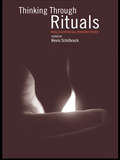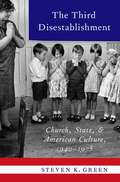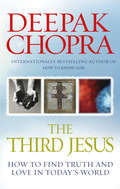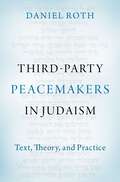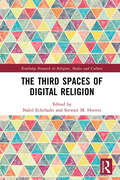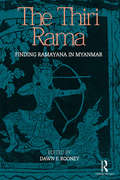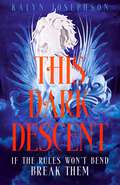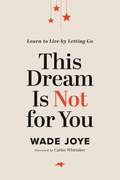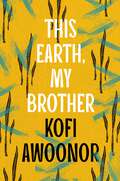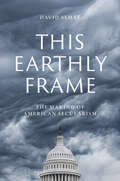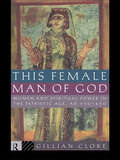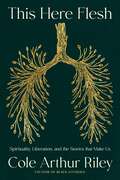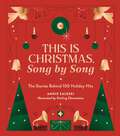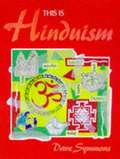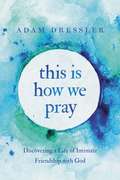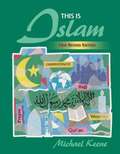- Table View
- List View
Thinking Through Rituals: Philosophical Perspectives
by Kevin SchilbrackMany philosophical approaches today seek to overcome the division between mind and body. If such projects succeed, then thinking is not restricted to the disembodied mind, but is in some sense done through the body. From a post-Cartesian perspective, then, ritual activities that discipline the body are not just thoughtless motions, but crucial parts of the way people think.Thinking Through Rituals explores religious ritual acts and their connection to meaning and truth, belief, memory, inquiry, worldview and ethics. Drawing on philosophers such as Foucault, Merleau-Ponty and Wittgenstein, and sources from cognitive science, pragmatism and feminist theory, it provides philosophical resources for understanding religious ritual practices like the Christian Eucharistic ceremony, Hatha Yoga, sacred meditation or liturgical speech. Its essays consider a wide variety of rituals in Christianity, Judaism, Hinduism and Buddhism - including political protest rituals and gay commitment ceremonies, traditional Vedic and Yogic rites, Christian and Buddhist meditation and the Jewish Shabbat. They challenge the traditional disjunction between thought and action, showing how philosophy can help to illuminate the relationship between doing and meaning which ritual practices imply.
Thinking Through Rituals: Philosophical Perspectives
by Kevin SchilbrackMany philosophical approaches today seek to overcome the division between mind and body. If such projects succeed, then thinking is not restricted to the disembodied mind, but is in some sense done through the body. From a post-Cartesian perspective, then, ritual activities that discipline the body are not just thoughtless motions, but crucial parts of the way people think.Thinking Through Rituals explores religious ritual acts and their connection to meaning and truth, belief, memory, inquiry, worldview and ethics. Drawing on philosophers such as Foucault, Merleau-Ponty and Wittgenstein, and sources from cognitive science, pragmatism and feminist theory, it provides philosophical resources for understanding religious ritual practices like the Christian Eucharistic ceremony, Hatha Yoga, sacred meditation or liturgical speech. Its essays consider a wide variety of rituals in Christianity, Judaism, Hinduism and Buddhism - including political protest rituals and gay commitment ceremonies, traditional Vedic and Yogic rites, Christian and Buddhist meditation and the Jewish Shabbat. They challenge the traditional disjunction between thought and action, showing how philosophy can help to illuminate the relationship between doing and meaning which ritual practices imply.
The Third Disestablishment: Church, State, and American Culture, 1940-1975
by Steven K. GreenIn 1947, the Supreme Court embraced the concept of church-state separation as shorthand for the meaning of the Establishment Clause of the First Amendment. The concept became embedded in Court's jurisprudence and remains so today. Yet separation of church and state is not just a legal construct; it is embedded in the culture. Church-state separation was a popular cultural ideal, chiefly for Protestants and secularists, long before the Supreme Court adopted it as a constitutional principle. While the Court's church-state decisions have impacted public attitudes--particularly those controversial holdings regarding prayer and Bible reading in public schools--the idea of church-state separation has remained relatively popular; recent studies indicate that approximately two-thirds of Americans support the concept, even though they disagree over how to apply it. In the follow up to his 2010 book The Second Disestablishment, Steven K. Green sets out to do examine the development of modern separationism from a legal and cultural perspective. The Third Disestablishment examines the dominant religious-cultural conflicts of the 1930s-1950s between Protestants and Catholics, but it also shows how other trends and controversies during mid-century impacted both judicial and popular attitudes toward church-state separation: the Jehovah's Witnesses' cases of the late-30s and early-40's, Cold War anti-communism, the religious revival and the rise of civil religion, the advent of ecumenism, and the presidential campaign of 1960. The book then examines how events of the 1960s-the school prayer decisions, the reforms of Vatican II, and the enactment of comprehensive federal education legislation providing assistance to religious schools-produced a rupture in the Protestant consensus over church-state separation, causing both evangelicals and religious progressives to rethink their commitment to that principle. Green concludes by examining a series of church-state cases in the late-60s and early-70s where the justices applied notions of church-state separation at the same time they were reevaluating that concept.
The Third Disestablishment: Church, State, and American Culture, 1940-1975
by Steven K. GreenIn 1947, the Supreme Court embraced the concept of church-state separation as shorthand for the meaning of the Establishment Clause of the First Amendment. The concept became embedded in Court's jurisprudence and remains so today. Yet separation of church and state is not just a legal construct; it is embedded in the culture. Church-state separation was a popular cultural ideal, chiefly for Protestants and secularists, long before the Supreme Court adopted it as a constitutional principle. While the Court's church-state decisions have impacted public attitudes--particularly those controversial holdings regarding prayer and Bible reading in public schools--the idea of church-state separation has remained relatively popular; recent studies indicate that approximately two-thirds of Americans support the concept, even though they disagree over how to apply it. In the follow up to his 2010 book The Second Disestablishment, Steven K. Green sets out to do examine the development of modern separationism from a legal and cultural perspective. The Third Disestablishment examines the dominant religious-cultural conflicts of the 1930s-1950s between Protestants and Catholics, but it also shows how other trends and controversies during mid-century impacted both judicial and popular attitudes toward church-state separation: the Jehovah's Witnesses' cases of the late-30s and early-40's, Cold War anti-communism, the religious revival and the rise of civil religion, the advent of ecumenism, and the presidential campaign of 1960. The book then examines how events of the 1960s-the school prayer decisions, the reforms of Vatican II, and the enactment of comprehensive federal education legislation providing assistance to religious schools-produced a rupture in the Protestant consensus over church-state separation, causing both evangelicals and religious progressives to rethink their commitment to that principle. Green concludes by examining a series of church-state cases in the late-60s and early-70s where the justices applied notions of church-state separation at the same time they were reevaluating that concept.
The Third Jesus: How to Find Truth and Love in Today's World
by Dr Deepak ChopraIn this dazzling book, one of the most influential spiritual thinkers of our time provides an answer that is as challenging as it is uplifting. Deepak Chopra searches for the Christ who stands at the heart of Christianity and discovers the identity of Jesus is threefold.Firstly, there is Jesus the man, who lived over 2000 years ago and whose sermons form the foundation of Christian theology. Secondly, there is Jesus the Son of God, who represents a specific branch of religion. Finally, there is the Third Jesus, the spiritual guide whose teachings embrace humanity as a whole.By considering each of these separate figures, Chopra allows us to decide for ourselves which of them speaks the most clearly to us today. As we become familiar with the universal wisdom of Christ, most especially through the guidance of the Third Jesus, we may become more open to a truly loving spirituality. And we will begin to create a brighter future, free from hatred fuelled by religious fundamentalism.
Third-Party Peacemakers in Judaism: Text, Theory, and Practice
by Daniel RothIn the race to discover real solutions for the conflicts that plague contemporary society, it is essential that we look to precedent. Many of today's conflicts involve ethno-religious tensions that modern wisdom alone is ill-equipped to resolve. In Third-Party Peacemakers in Judaism, Rabbi Dr. Daniel Roth asks us to consider ancient religious and traditional cultural solutions to such present-day issues. Roth presents thirty-six case studies featuring third-party peacemakers drawn from Jewish classical, medieval, and early-modern rabbinic literature. Each case is explored through three layers of analysis - text, theory, and practice. The first layer offers historical and literary analysis of textual case studies, many of which are critically analyzed here for the first time. The second layer examines the theoretical model of third-party peacemaking imbedded within the selected cases and comparing them to other cultural and religious models of third-party peacemaking and conflict resolution. The final layer of analysis, based upon the author's personal experience of religious conflict resolution and peacemaking, looks at the practical implications of these case studies as models for modern peacemaking. Third-Party Peacemakers in Judaism serves as an inspiration for fostering indigenous practices of third-party peacemaking and mediation in the modern era.
Third-Party Peacemakers in Judaism: Text, Theory, and Practice
by Daniel RothIn the race to discover real solutions for the conflicts that plague contemporary society, it is essential that we look to precedent. Many of today's conflicts involve ethno-religious tensions that modern wisdom alone is ill-equipped to resolve. In Third-Party Peacemakers in Judaism, Rabbi Dr. Daniel Roth asks us to consider ancient religious and traditional cultural solutions to such present-day issues. Roth presents thirty-six case studies featuring third-party peacemakers drawn from Jewish classical, medieval, and early-modern rabbinic literature. Each case is explored through three layers of analysis - text, theory, and practice. The first layer offers historical and literary analysis of textual case studies, many of which are critically analyzed here for the first time. The second layer examines the theoretical model of third-party peacemaking imbedded within the selected cases and comparing them to other cultural and religious models of third-party peacemaking and conflict resolution. The final layer of analysis, based upon the author's personal experience of religious conflict resolution and peacemaking, looks at the practical implications of these case studies as models for modern peacemaking. Third-Party Peacemakers in Judaism serves as an inspiration for fostering indigenous practices of third-party peacemaking and mediation in the modern era.
The Third Spaces of Digital Religion (Routledge Research in Religion, Media and Culture)
by Nabil Echchaibi Stewart M. HooverThis exciting volume explores how religious meaning is generated and performed in our present digital media ecosystem. It uses the spatial metaphor of a third space to visualize the mobility of everyday religion and to explore the dynamic ways in which contemporary subjects imagine, produce, and navigate new religious and spiritual places. Comprised of seven original essays, this book provides a rigorous discussion of the complex intersections of the digital and religion, demonstrating how third spaces of religion stand out by virtue of their in-betweenness. They exist between private and public, between institution and individual, between authority and individual autonomy, between large media framings and individual "pro-sumption," and between local and translocal. Including probing analysis of how Muslim, Catholic, and Neo-Pagan identities are cultivated and developed online, case studies reflect on the creative outcomes of this condition of in-betweenness and the emergence of other places of religious and spiritual meaning. Blending theoretical analysis with grounded empirical research, this book is essential reading for students and scholars of contemporary religion, media and religion, sociology of religion, religion, and popular culture.
The Third Spaces of Digital Religion (Routledge Research in Religion, Media and Culture)
by Nabil Echchaibi Stewart M. HooverThis exciting volume explores how religious meaning is generated and performed in our present digital media ecosystem. It uses the spatial metaphor of a third space to visualize the mobility of everyday religion and to explore the dynamic ways in which contemporary subjects imagine, produce, and navigate new religious and spiritual places. Comprised of seven original essays, this book provides a rigorous discussion of the complex intersections of the digital and religion, demonstrating how third spaces of religion stand out by virtue of their in-betweenness. They exist between private and public, between institution and individual, between authority and individual autonomy, between large media framings and individual "pro-sumption," and between local and translocal. Including probing analysis of how Muslim, Catholic, and Neo-Pagan identities are cultivated and developed online, case studies reflect on the creative outcomes of this condition of in-betweenness and the emergence of other places of religious and spiritual meaning. Blending theoretical analysis with grounded empirical research, this book is essential reading for students and scholars of contemporary religion, media and religion, sociology of religion, religion, and popular culture.
The Thiri Rama: Finding Ramayana in Myanmar
by Dawn F. RooneyThe Thiri Rama – or the Great Rama – was written for court performance and is the only known illustrated version of the Ramayana story in Myanmar. Based on palm-leaf manuscripts and scenes carved on over 300 sandstone plaques at a mid-nineteenth-century Buddhist pagoda west of Mandalay in Myanmar, this book presents an original translation of the Thiri Rama rendered in prose. The volume also includes essays on the history and tradition of the Ramayana in Myanmar as well as the cultural context in which the play was performed. It contains many helpful resources, incorporating a glossary and a list of characters and their corresponding personae in Valmiki’s Ramayana. With over 250 fascinating visuals and core text contributions by distinguished Burmese scholars, U Thaw Kaung, Tin Maung Kyi, and U Aung Thwin, this book will greatly interest scholars and researchers of South and Southeast Asian culture, literary forms, epics, art and art history, theatre and performance studies, religion, especially those concerned with Hinduism, as well as folklorists.
The Thiri Rama: Finding Ramayana in Myanmar
by Dawn F. RooneyThe Thiri Rama – or the Great Rama – was written for court performance and is the only known illustrated version of the Ramayana story in Myanmar. Based on palm-leaf manuscripts and scenes carved on over 300 sandstone plaques at a mid-nineteenth-century Buddhist pagoda west of Mandalay in Myanmar, this book presents an original translation of the Thiri Rama rendered in prose. The volume also includes essays on the history and tradition of the Ramayana in Myanmar as well as the cultural context in which the play was performed. It contains many helpful resources, incorporating a glossary and a list of characters and their corresponding personae in Valmiki’s Ramayana. With over 250 fascinating visuals and core text contributions by distinguished Burmese scholars, U Thaw Kaung, Tin Maung Kyi, and U Aung Thwin, this book will greatly interest scholars and researchers of South and Southeast Asian culture, literary forms, epics, art and art history, theatre and performance studies, religion, especially those concerned with Hinduism, as well as folklorists.
Thirukailaya Gyana Ula
by Seraman Perumal NayanarThis work is part of the 11th Thirumurai.'Ula' is one of the 96 types of 'Sitrillakiyam'. Also called 'Adhi Ula' as it is the first in the Ula genre.It talks in praise of Lord Shiva and how women of all ages are mesmerized by his charisma.
Thiruppavai
by AndalPart of Naalayira thivvya prabantham, Thriuppavai is a collection of 30 songs sung by Andal in praise of the Lord Mahavishnu. These songs are sung typically in the Tamil month of marghazhi culminating in the pongal festival in the month of Thai. It is said that Andal merged one with God at the end of these thirty days.
This Dark Descent: Enter the Illinir, the cut-throat horse race where your options are win - or die
by Kalyn JosephsonEnter the corrupt world of Veradell, where warring monarchs vie for a kingdom full of forbidden magic, illicit romance and cut-throat horse racing. Steeped in Jewish folklore, This Dark Descent is an explosive YA fantasy by Kalyn Josephson, perfect for fans of Leigh Bardugo's Six of Crows.Mikira Rusel is out of options. With her father imprisoned and facing rising debts, there’s only one way to save her family from ruin: enter the Illinir, a high-stakes, cross-country horse race known for its high death toll as much as its flashy prize money.To have any chance of success she’ll have to recruit Ari, an unlicensed enchanter, Damien, a lord in the midst of a succession battle, and Reid; the brooding horse trainer who will be the key to Mikira’s survival.All her accomplices have reasons of their own to help Mikira - and their own blood feuds to avenge. And as alliances deepen and romances form, Mikira will have to discover where everyone’s true loyalties lie.In a world as dangerous as this, remember to keep your enemies close and your friends closer . . .
This Dream Is Not for You: Learn to Live by Letting Go
by Wade JoyeChristian speaker and Bible teacher Wade Joye pushes back against the dominant self-help teaching of the day—to follow your dreams—and encourages us to let go and surrender our lives to God in order to truly live. &“Follow your dreams&” is the self-help message of our day. In our schools and universities, media, and culture, and even in church, we are taught to dream big, work hard, and find true happiness in living our dreams. And so we spend our lives chasing. But as we chase our dreams, we can be met with exhaustion, anxiety, and disappointment. Our circumstances may put our dreams in jeopardy, or even deny them—and we&’re heartbroken. Or we achieve them and just want more. Wade Joye offers here a different way. Release your grip on your dreams and trust God with your whole life. Joye shows that by letting go we are freed from the pressure to secure some ideal, unattainable life, and instead become open to God and his plans. Living a life of daily surrender to God&’s purpose we begin to see glimpses of God in our present circumstance, as he shows us that he, more than anyone, can be trusted. With deep wisdom, frank teaching, and a pastor&’s heart, Wade guides readers step-by-step to the place of letting go, the place where we find real life.
This Earth, My Brother
by Kofi AwoonorIn this debut novel, Kofi Awoonor brilliantly interweaves poetry and allegory into a profound tale of social corruption in post-colonial Ghana. Rooted in the African oral tradition, This Earth, My Brother paints a picture of post-independent Ghana through two distinctive narratives. In the first strand, we find Amamu, a young lawyer struggling to come to terms with his place amongst the new Ghanaian elite. Frustrated by the debauchery of his peers, and the misery engulfing the country, he decides to leave. During his journey across Europe, Amamu is gripped with a different kind of spiritual alienation – one that he can't run away from.Bridging the gaps between Amamu's story are chapters of rich prose poetry that tell an allegorical tale of new Ghana. From religious suffering to mermaids, Kofi Awoonor lyrically captures the inner workings of a man's disturbed conscience and the conflicting realities of Ghana's independence.'Wonderfully musical prose.' Guardian 'A great and powerful literary personality.' Auma Obama
This Earthly Frame: The Making of American Secularism
by David SehatAn award-winning scholar’s sweeping history of American secularism, from Jefferson to Trump“An essential book for understanding today’s culture wars. Sehat’s clear-eyed and elegant narrative will change how you think about our supposedly secular age.”—Molly Worthen, University of North Carolina at Chapel Hill In This Earthly Frame, David Sehat narrates the making of American secularism through its most prominent proponents and most significant detractors. He shows how its foundations were laid in the U.S. Constitution and how it fully emerged only in the twentieth century. Religious and nonreligious Jews, liberal Protestants, apocalyptic sects like the Jehovah’s Witnesses, and antireligious activists all used the courts and the constitutional language of the First Amendment to create the secular order. Then, over the past fifty years, many religious conservatives turned against that order, emphasizing their religious freedom. Avoiding both polemic and lament, Sehat offers a powerful reinterpretation of American secularism and a clear framework for understanding the religiously infused conflict of the present.
This Female Man of God: Women and Spiritual Power in the Patristic Age, 350-450 AD
by Gillian ClokeThis book is a study of the contribution of women to the development of the newly legitimate Christian church in the twilight of the Western Roman Empire. There are many women noted for the example of their life in this period, regarded amongst the luminaries of the day; but while their male mentors, the patristic authors have retained their fame, the women who surrounded and influenced them have all but disappeared from sight. The women themselves are partly to blame for this, for in order to be pious it made sense to disguise one's sex sometimes literally: Dr Cloke gives examples of those whose sex was discovered only after their death - they sought to become androgynous, a third sex before God. This book looks at a multitude of examples in some detail and takes an overview of the role of Christian women at this time. It should appeal not only to historians, classicists and theologians, but also to anyone who takes a general interest in the changing status of women over the the centuries.
This Female Man of God: Women and Spiritual Power in the Patristic Age, 350-450 AD
by Gillian ClokeThis book is a study of the contribution of women to the development of the newly legitimate Christian church in the twilight of the Western Roman Empire. There are many women noted for the example of their life in this period, regarded amongst the luminaries of the day; but while their male mentors, the patristic authors have retained their fame, the women who surrounded and influenced them have all but disappeared from sight. The women themselves are partly to blame for this, for in order to be pious it made sense to disguise one's sex sometimes literally: Dr Cloke gives examples of those whose sex was discovered only after their death - they sought to become androgynous, a third sex before God. This book looks at a multitude of examples in some detail and takes an overview of the role of Christian women at this time. It should appeal not only to historians, classicists and theologians, but also to anyone who takes a general interest in the changing status of women over the the centuries.
This Here Flesh: Spirituality, Liberation and the Stories That Make Us
by Cole Arthur Riley'This is the kind of book that make you different when you're done.' - Ashley C. Ford, New York Times bestselling author of Somebody's Daughter'From the womb, we must repeat with regularity that to love ourselves is to survive. I believe that is what my father wanted for me and knew I would so desperately need: a tool for survival, the truth of my dignity named like a mercy new each morning.'So writes Cole Arthur Riley in an unforgettable book of stories and reflections on discovering the sacred in her skin. In these deeply transporting pages, Cole reflects on the stories of her grandmother and father and encounters of enfleshed, embodied spirituality. As she writes memorably of her own lived experiences of childhood and selfhood, Cole boldly explores some of the most urgent questions of life and faith: How can spirituality not silence the body, but instead allow it to come alive? How do we honour, lament, and heal from the stories we inherit?How can we find peace in a world overtaken with dislocation, noise, and unrest? At once a compelling spiritual meditation and a tender coming-of-age narrative, This Here Flesh invites us to ponder the site of the soul by examining our capacity to rest, wonder, joy, rage, and repair - and finding that our humanity is not an enemy to faith but evidence of it.'Exquisite' - Ayo Tomenti, co-founder of Black Lives Matter
This Is Christmas, Song by Song: The Stories Behind 100 Holiday Hits
by Annie ZaleskiCelebrate the merriest season of the year with award-winning author and music journalist Annie Zaleski's collection of the 100 most popular and beloved holiday songs of all time. 'Tis the season! Break out the eggnog, hang the mistletoe, blast those Christmas songs, and settle down in your favorite armchair with this beautifully illustrated volume exploring well-known and lesser-known behind-the-scenes stories of the 100 most cherished holiday songs of all time and their everlasting impact. From artists such as Bing Crosby and Ella Fitzgerald all the way up to Mariah Carey and Ariana Grande, this all-encompassing collection of holiday favorites (called one of "the 25 best Christmas books of all time" by Book Riot) is sure to warm your heart during the merriest season of the year. What song was listed in the Guinness Book of World Records as the best-selling single of all time? Which popular Christmas tune was reportedly written to commemorate Thanksgiving? What holiday song led to a special meet-and-greet between the song's 10-year-old singer and a 700-pound hippopotamus? Spanning musical genres and decades of classics and modern hits, some of the featured songs include: &“White Christmas&” by Bing Crosby "All I Want for Christmas Is You" by Mariah Carey "Deck the Halls" by Mannheim Steamroller &“Christmas Tree Farm&” by Taylor Swift &“Christmas Time (Is Here Again)" by The Beatles &“Feliz Navidad&” by José Feliciano "Rudolph the Red-Nosed Reindeer" by Gene Autry "You Make It Feel Like Christmas" by Gwen Stefani &“Santa Baby&” by Eartha Kitt &“Rockin&’ around the Christmas Tree&” by Brenda Lee &“Merry Christmas, Happy Holidays&” by NSYNC &“Run Rudolph Run&” by Chuck Berry And many more! Including full-color illustrations throughout, this gorgeously packaged compendium is the perfect gift for you and your loved ones to experience the holiday magic year after year.
This is Hinduism
by David SymmonsThis is Hinduism provides a clear and coherent approach, ideal for use by specialist and non-specialist teachers. It provides an in-depth treatment of the Hindu religion, and presents material which is suitable for use with many locally agreed syllabuses. It offers a variety of learning styles and a wealth of resource and stimulus material. It also compares world-wide beliefs and practices, fulfilling RE guidelines for QCA by ensuring an understanding of the role of other faiths in Britain.
This Is How We Pray: Discovering a Life of Intimate Friendship with God
by Adam DresslerThis book is about making room: God making room for us. Us making room for God. And through this relationship we end up becoming people who knew firsthand what it means to walk with God.This Is How We Pray offers a fresh invitation to examine how we pray. Theology and doctrine can feel overwhelming. And specific devotional practices can feel too limiting. Instead, this book offers a unique and needed perspective on prayer, inviting you into a more intimate friendship with God.Through personal anecdotes, biblical stories, ancient wisdom, and modern insights from spiritual writers, philosophers, and even cooking documentaries, Adam Dressler walks through the realities we face in the midst of our everyday lives, and then shows how they can direct us towards a deeper friendship with God through our prayers.God promises to meet with us. This Is How We Pray points to this timeless truth and reminds us that we can experience this promise right where we are.
This Is How We Pray: Discovering a Life of Intimate Friendship with God
by Adam DresslerThis book is about making room: God making room for us. Us making room for God. And through this relationship we end up becoming people who knew firsthand what it means to walk with God.This Is How We Pray offers a fresh invitation to examine how we pray. Theology and doctrine can feel overwhelming. And specific devotional practices can feel too limiting. Instead, this book offers a unique and needed perspective on prayer, inviting you into a more intimate friendship with God.Through personal anecdotes, biblical stories, ancient wisdom, and modern insights from spiritual writers, philosophers, and even cooking documentaries, Adam Dressler walks through the realities we face in the midst of our everyday lives, and then shows how they can direct us towards a deeper friendship with God through our prayers.God promises to meet with us. This Is How We Pray points to this timeless truth and reminds us that we can experience this promise right where we are.
This is Islam
by Michael KeeneThis is a topic book on Islam for Key Stage 3 providing an in-depth treatment. It is one of a series which compares world-wide beliefs and practices fulfilling RE guidelines for QCA by ensuring an understanding of the role of other faiths in Britain.
